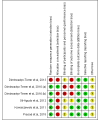Virtual Reality Systems for Upper Limb Motor Function Recovery in Patients With Spinal Cord Injury: Systematic Review and Meta-Analysis
- PMID: 33270040
- PMCID: PMC7746495
- DOI: 10.2196/22537
Virtual Reality Systems for Upper Limb Motor Function Recovery in Patients With Spinal Cord Injury: Systematic Review and Meta-Analysis
Abstract
Background: Patients with spinal cord injury (SCI) usually present with different motor impairments, including a deterioration of upper limb motor function (ULMF), that limit their performance of activities of daily living and reduce their quality of life. Virtual reality (VR) is being used in neurological rehabilitation for the assessment and treatment of the physical impairments of this condition.
Objective: A systematic review and meta-analysis was conducted to evaluate the effectiveness of VR on ULMF in patients with SCI compared with conventional physical therapy.
Methods: The search was performed from October to December 2019 in Embase, Web of Science, Cumulative Index to Nursing and Allied Health Literature (CINAHL), Scopus, Medline, Physiotherapy Evidence Database (PEDro), PubMed, and Cochrane Central Register of Controlled Trials. The inclusion criteria of selected studies were as follows: (1) comprised adults with SCI, (2) included an intervention with VR, (3) compared VR intervention with conventional physical therapy, (4) reported outcomes related to ULMF, and (5) was a controlled clinical trial. The Cochrane Collaboration's tool was used to evaluate the risk of bias. The RevMan 5.3 statistical software was used to obtain the meta-analysis according to the standardized mean difference (SMD) and 95% CIs.
Results: Six articles were included in this systematic review. Four of them contributed information to the meta-analysis. A total of 105 subjects were analyzed. All of the studies used semi-immersive or nonimmersive VR systems. The statistical analysis showed nonsignificant results for the Nine-Hole Peg Test (SMD -0.93, 95% CI -1.95 to 0.09), muscle balance test (SMD -0.27, 95% CI -0.82 to 0.27), Motricity Index (SMD 0.16, 95% CI -0.37 to 0.68), Jebsen-Taylor Hand Function Test (JTHFT) subtests (writing, SMD -0.10, 95% CI -4.01 to 3.82; simulated page turning, SMD -0.99, 95% CI -2.01 to 0.02; simulated feeding, SMD -0.64, 95% CI -1.61 to 0.32; stacking checkers, SMD 0.99, 95% CI -0.02 to 2.00; picking up large light objects, SMD -0.42, 95% CI -1.37 to 0.54; and picking up large heavy objects, SMD 0.52, 95% CI -0.44 to 1.49), range of motion of shoulder abduction/adduction (SMD -0.23, 95% CI -1.48 to 1.03), shoulder flexion/extension (SMD 0.56, 95% CI -1.24 to 2.36), elbow flexion (SMD -0.36, 95% CI -1.14 to 0.42), elbow extension (SMD -0.21, 95% CI -0.99 to 0.57), wrist extension (SMD 1.44, 95% CI -2.19 to 5.06), and elbow supination (SMD -0.18, 95% CI -1.80 to 1.44). Favorable results were found for the JTHFT subtest picking up small common objects (SMD -1.33, 95% CI -2.42 to -0.24).
Conclusions: The current evidence for VR interventions to improve ULMF in patients with SCI is limited. Future studies employing immersive systems to identify the key aspects that increase the clinical impact of VR interventions are needed, as well as research to prove the benefits of the use of VR in the rehabilitation of patients with SCI in the clinical setting.
Keywords: motor function; neurological rehabilitation; physical therapy; spinal cord injuries; virtual reality.
©Amaranta De Miguel-Rubio, M Dolores Rubio, Alvaro Alba-Rueda, Alejandro Salazar, Jose A Moral-Munoz, David Lucena-Anton. Originally published in JMIR mHealth and uHealth (http://mhealth.jmir.org), 03.12.2020.
Conflict of interest statement
Conflicts of Interest: None declared.
Figures








References
-
- Dimbwadyo-Terrer I, Gil-Agudo A, Segura-Fragoso A, de los Reyes-Guzmán A, Trincado-Alonso F, Piazza S, Polonio-López B. Effectiveness of the Virtual Reality System Toyra on Upper Limb Function in People with Tetraplegia: A Pilot Randomized Clinical Trial. Biomed Res Int. 2016;2016:6397828. doi: 10.1155/2016/6397828. doi: 10.1155/2016/6397828. - DOI - DOI - PMC - PubMed
-
- Birckhead B, Khalil C, Liu X, Conovitz S, Rizzo A, Danovitch I, Bullock K, Spiegel B. Recommendations for Methodology of Virtual Reality Clinical Trials in Health Care by an International Working Group: Iterative Study. JMIR Ment Health. 2019 Jan 31;6(1):e11973. doi: 10.2196/11973. https://mental.jmir.org/2019/1/e11973/ - DOI - PMC - PubMed

